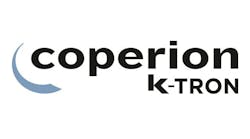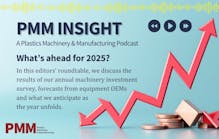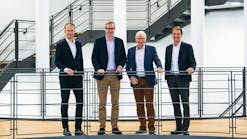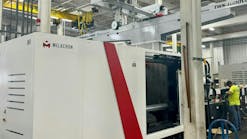Not many people can say they’ve launched a successful, rapidly growing company in a highly competitive industry. But Bill Kramer, president of US Extruders, Westerly, R.I., has done just that twice. Kramer co-founded American Kuhne in 1997 and 20 years later launched US Extruders with six other former American Kuhne employees.
Kramer, 67, discussed his career with Bruce Adams, Plastics Machinery Magazine senior staff reporter.
How did you get started in plastics and extrusion?
Kramer: I started out working in the shop at Davis-Standard as an unskilled apprentice in 1970. I worked my way up to lead man and started attending night school. I began to work in the engineering department as a draftsman while attending night school and worked my way up to engineering manager in less than 10 years. I worked at Davis-Standard until 1997, when I co-founded American Kuhne with Ed Steward, who was a screw designer at Davis-Standard. We started it because we saw an opportunity to build custom extruders for small companies. Larger companies wanted to sell standardized extruders to keep their costs in line. We started American Kuhne in partnership with Kuhne GmbH in Germany, which primarily was a financial supporter. With their financial banking, we grew the company rapidly and at the end of our first year we had 15 employees. I was president of American Kuhne from 1997 until 2015.
How did your path lead to US Extruders?
Kramer: In 2012 or 2013, majority ownership of American Kuhne transferred to Graham Engineering. They closed the American Kuhne facility in Rhode Island and merged that into a brand as part of their operation in Pennsylvania. American Kuhne had about 50 employees in their Rhode Island facility, and most of them did not move to Pennsylvania. After waiting through our non- compete period, I was one of seven former American Kuhne employees to start US Extruders in September 2017.
What did you bring to the market that you felt had been lacking?
Kramer: This is the same story as when we launched American Kuhne. We felt there was an opportunity to supply extruders with customized configurations to companies. This time, we had a lot more experience. The seven of us covered the spectrum of what was needed to run an extrusion company: engineers, screw designer and manufacturing operations. We started with a lot of talent and knew how important it was to provide attention to detail — from project quote to the delivery of the extruder. That appears to be difficult for some large companies to do on individual extruders. When we started American Kuhne, it was two young guys looking to start a new venture. At US Extruders, we had a larger group of veteran workers who needed to do something different or find a way to stay in the business. We had knowledge, love and passion for extruders and decided to stay in the industry.
Your focus is single-screw, highly engineered and customized extruders. Why that niche?
Kramer: We concentrate on extruders, not the downstream items. We know that area very well, including profile to sheet to film — all the processes. There are many customers that want to buy custom extruders, so the market is large.
Let’s talk about the design of the Med-Ex Medical Extruder that you introduced at MD&M West. It has a barrel that’s removable via a simple clamp design. There are no pressure transducers. Was that to eliminate a potential area of contamination and corrosion?
Kramer: Yes. Eliminating the pressure transducer and the rupture disc at the end of the barrel on small machines does that. It also allows us to extend the heater to get better coverage in that area. In conventional extruders, that area is a cold spot. Our design allows us to bring the heater to the back side of the clamp.
Instead of pressure transducers, you are using a patent-pending, virtual pressure- measurement system. How does that work?
Kramer: Extruder discharge pressure measurement using a conventional transducer presents a problem in corrosive applications and for very small extruders, where the pocket formed in the barrel wall at the sensor hole is large relative to diameter and is a source for degradation and corrosion. Also, it is located relatively far from the screw tip on small machines.
US Extruders has developed a new method of measuring extruder discharge pressure utilizing the axial force of the screw against the thrust bearing as an indirect means of measurement. The extruder is equipped with a force sensor behind the thrust bearing, and this value is input to an algorithm along with drive torque to calculate a virtual pressure value that is scaled to conventional units. The pressure transducer and rupture disc, and their barrel ports, are eliminated.
Virtual pressure is displayed on the HMI or via a special discrete instrument complete with alarms and shut-down limits. The design also allows for the last barrel heater to cover the area formerly occupied by the transducer and rupture disc, which was a cold spot before the new design.
Was there an “aha moment” in how you built any of your machines?
Kramer: We had the opportunity at the beginning to start with a blank sheet of paper for design. We realized that a one-piece barrel gives us better alignment and eliminates a joint. But that is more evolutionary than revolutionary. There have been lots of little moments, not big ones.
Do you use robots in manufacturing?
Kramer: No. We have advanced machining and manufacturing used in some of the components, such as laser cutting equipment for machine parts. Machine parts are done on a multi-axis machine.
What was your greatest challenge in growing your company?
Kramer: US Extruders has been very fortunate with our mix of talent and expertise. One challenge is keeping our commitment [to excellence] as the business grows. Another is balancing and scheduling the work load and the variety of what we build. We have lots of small challenges.
Who buys your extruders?
Kramer: We serve a wide spectrum from large multinational companies to independent processors. We are not marketing outside the U.S. because we want to make sure we can support everything we sell. We are using as many U.S.-based suppliers as possible. That relationship is very important to us. We want to avoid issues that often occur with foreign suppliers.
What is your delivery time on built-to- order machines?
Kramer: For a conventional extruder, it’s 16 to 18 weeks from approved specification to delivery.
What evolutions in machine technology have had the greatest impact on your business?
Kramer: The biggest things are in the controls and motors. An extruder today looks quite a bit like it would have looked 20 years ago.
How do you see technology impacting the industry? What will the industry look like in 20 years?
Kramer: Twenty years from now, extruders will have a similar configuration to what we see today. The controls area and communications in the factory floor, what some people refer to as Industry 4.0, need to become more practical and useful. A standard for machinery now is to say it can communicate to the controller and get access to any data you want. The industry wants machines communicating with their production database, but no standards are evolving. It will occur as customers define what they need.
What have you been working on lately?
Kramer: The Med-Ex Medical Extruder that we introduced in February at the MD&M show in Anaheim, Calif. That was the first operating example of that extruder. We are still engineering and developing it.
How many patents does your company have?
Kramer: The company has a patent pending on the virtual pressure measurement, which is on the Med-Ex Medical Extruder.
How would you like to be remembered?
Kramer: It’s too early to think about that.
Bruce Adams, senior staff reporter







